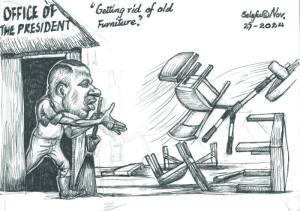Next Tuesday is a D-day for many parents. After a month long and eventful recess, many parents would be welcoming, with a sense of great relief the opportunity to have their children back in school.
Let us begin with the home environment.
At home, the children are no longer spectators. They are very much hands-on. When returning to school, children expect to continue, of course within the parameters of school rules, their action packed way of life. Sitting on the fence is not their thing. As much as they are a blessing, these 21st century children can be quite a handful. They are hyperactive and restless creatures, hardly knowing any sleep at night and could literally ‘ransack’ a well stocked refrigerator overnight. Their long-awaited return to the classrooms would ease the worries of many parents, albeit temporarily. As the schools take over the baton, their readiness to discharge their functions effectively and effeciently is of paramount significance. Readiness comes in different forms. It could be physical, psychological, and pedagogical.
Physically, the school environment should be appealing. It does not always take much to develop and sustain a supportive and encouraging physical space. The secret lies in keeping the environment clean, with good and attractive landscaping, and if funds permit carrying out regular minor maintenance works and repairs could add to the psychological boost. Psychological readiness means feeling good about one self and one’s school. Students should cultivate a sense of pride in their teachers and teacchers should also have positive attitudes towards their students. Pedagogical readiness would mean the readiness of teachers to deliver instruction in an engaging and stimulating manner plus a corresponding readiness by the students to receive classroom instruction while also displaying eagerness to give back.
Of these three factors, the most important one is the ability to create a stimulating classroom engagement. Creating a rich and well blended teaching and learning experience begins with knowing and appreciating the character of the 21st century learner.
Who are these learners, and what are their demands? A school can only thrive when its pedagogical package is tailor-made to satisfy its clientele - the modern learner. Old and discredited pedagogical approaches anchored much on the performance of one single actor - the teacher - are no longer appealing. But today’s 21st century generation is seeking a stake in the teaching and learning environment. They have found their voices back at home and they demand freedom of expression for their voices to be heard even at school. As they say, nothing for us without us.
The school should draw inspiration from the home environment. At home, the children have found their voices. They are no spectators. The 21st century learners right from infancy are growing with an inquiry mind. They are asking their parents difficult and unsettling questions, demanding answers to issues traditionally considered to be ‘child no go areas’.
They are exposed 24/7 to technology, enabling them to discover new information on their own, unaided by the parents. Through technology, they are able to hone and nurture their research and inquiry skills.
Effectively, the home environment allows room for robust debates, group work, experimentation, and innovation. These are useful learning tools and skills that children are bringing to the school.
Meeting the needs of a 21st-century learner is enhanced in a school environment where skills of inquiry, research, innovation and problem solving embedded in each and every child are sharpened and not frustrated. In other words, the quest for improved learning outcomes can begin to bear fruit if the school environment were to recognise students as a powerful learning resource. An environment where students are forced to sit and passively watch classroom proceedings guided by the teacher is, at best, less exciting and, at worst, undermines the resourcefulness of the student community. Perhaps the culture of academic-underachievement, presently bedeviling schools, is caused by the continuing underutilisation of the students as a learning resource. While there is a problem of shortage of resources in schools but it should be noted that the use of available resources is far from optimal.
The one resource not fully tapped is the student resource. This challenge is the one single road block that must be removed. To fully exploit the abilities of students, pedagogy must change from dictating terms to students to a high level of positive engagement. The biggest stumbling block standing in the way of efforts to turnaround chronically low achieving schools is the use of outdated pedagogy. When observing teaching practice envronment in senior secondary schools, Professor Jaap Kuiper summed it better when he said, “teaching uses limited activities, is outdated, and has largely been reduced to mere drilling and does not show any knowledge of present day best global practice in education.” The school environment should change radically from being a tense and intimidating one, to a relaxed, flexible environment accommodating high expectations from students. Best pedagogy is the one that moves the learner from the periphery to the centre.





